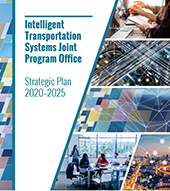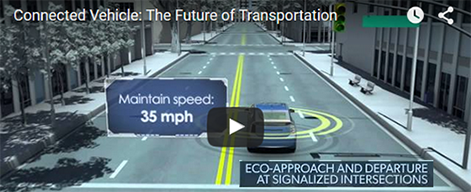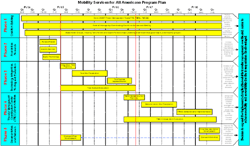Research Archive
Slide 1. Mobility Services for All Americans Initiative
ITS JPO Lead: Yehuda Gross
Technical Lead: Brian Cronin/William Wiggins, FTA APTS Division
Slide 2. Challenge
- 62 Federal programs fund human service transportation:
- Overlapping, fragmented, and unavailable transportation services
- Inadequate customer service
- Transportation service providers experience:
- High costs
- Limited revenues
- Underutilized vehicle capacity
Slide 3. Opportunity
- Federal Interagency United We Ride Initiative
- Presidential Executive Order on Human Service Transportation Coordination
- Several Past and Current USDOT ITS Activities
- Existing and Proven Technologies to Enhance Transportation Accessibility and Service Coordination
Slide 4. Goals
- Through service coordination and technology integration to …
- Increase mobility and transportation accessibility for the transportation disadvantaged and the general public
- Achieve more efficient use of federal transportation funding resources
Slide 5. Milestone/End Product
- Replicable/Scalable Traveler Management Coordination Center (TMCC) that provides one-stop, unified, customer-based travel information and trip planning services, and supports coordinated human service transportation operations.
Slide 6. Roadmap
Emphasize that all three levels of coalitions (Phase 1) will be "on duty" THROUGHOUT the entire program period.
Two key decision points are highlighted in red. The following few slides will provide closer looks to the five proposed phases.
Slide 7. Program Plan/Approach
- The Initiative consists of five phases
- Phase 1: Coalition Building
- Phase 2: Foundation Research
- Phase 3: Technology Integration Field Operational Tests and Evaluations
- Phase 4: Traveler Management Coordination Center Model Deployment
- Phase 5: Technology Transfer and Outreach
- Duration of Initiative
- FY04–FY08
Slide 8. Phase 1: Coalition Building
- Goal: Facilitate inter-agency coordination and cooperation, and promote knowledge and information sharing between transportation and ITS and human services communities.
- Actions
- Establish Three Levels of Coalition Building
- Core USDOT intermodal team
- Federal interagency coordinating council
- Stakeholder advisory/working groups
Slide 9. Phase 2: Foundation Research
- Goal: Integrate knowledge across disciplines; provide an information repository; and establish the baseline for performance measurement.
- Actions:
- Identify needs, gaps and barriers in current human service transportation practice
- Inventory past and existing human service transportation-related projects, and note-worthy state and local business models and initiatives
- Assess and prioritize technologies based on their abilities to address the needs/gaps and barriers, and their readiness for widespread deployment
- Go/No-go decision point
- Actions:
Slide 10. Phase 3: Technology Integration Field Operational Tests
- Goal: Allow intermediate advances and assessment of technologies for human service transportation coordination under different operating environments and scenarios.
- Actions:
- Plan, prepare and implement up to three field operational test sites
- Conduct independent test evaluations
- Go/No-go decision point
- Actions:
Slide 11. Phase 4: Model Deployment
- Goal: Create a replicable/scalable model of traveler management coordination center (TMCC) that provides one-stop, customer-based travel services, and supports coordinated human service transportation operations
- Actions:
- Plan, prepare and implement a TMCC demonstration
- Conduct an independent TMCC demonstration evaluation
- Actions:
Slide 12. Phase 5: Technology Transfer and Outreach
- Goal: Promote a widespread practice of human service transportation coordination through well designed and articulated outreach and professional capacity building activities.
- Actions:
- Develop technology transfer and outreach plans
- Perform technology transfer and outreach activities so that more people can enjoy the benefits of enhanced accessibility and mobility.
- Actions:
Slide 13. Summary
- Three Levels of Coalition Building
- Core USDOT Intermodal Team
- Federal Interagency Coordinating Council
- Stakeholder Advisory/Working Groups
- Five-phase Approach
- Coalition Building
- Foundation Research
- Technology Integration, Testing and Evaluation
- Replicable/Scalable Traveler Management Coordination Center Demonstration
- Technology Transfer and Outreach
- One Outcome
- Enhanced mobility and accessibility through technology integration and service coordination with efficient use of resources












